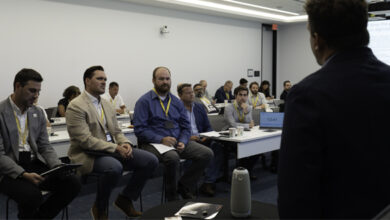Hybrid heave drilling technology reduces emissions, operating costs for offshore drilling
By Kevin R. Williams, KRW Technologies
Many electro-mechanical cyclical processes could potentially benefit from the use of an energy storage system able to absorb, store and relinquish large amounts of energy. Commonly used energy storage systems, such as batteries (chemical), hydraulic accumulators, or capacitors (electrical), are limited by size, weight, cost, capacity, power output, cycling, reliability or efficiency considerations. A spinning flywheel (kinetic energy storage) is an ideal and cost-effective way to store large amounts of readily available energy.
| A full version of this article, including the supporting mathematical equations, can be downloaded here. |

Hydrocarbon and NoX emissions were reduced by the same amount as the fuel savings (75%) while carbon monoxide and particulate matter were reduced by 92% and 80%, respectively, due to the optimized operating range of the genset engines.
KRW Technologies developed an innovative energy storage system that can result in reduced fuel consumption, reduced emissions and maximized engine life during drilling operations on deepwater rigs using energy produced by the rig’s active heave compensation system and a series of flywheels.
A flywheel-based energy storage system stores energy in the form of a rotating mass, which is immediately available to be converted to DC power. The energy storage system connects to the bus of an uninterruptable power supply (UPS) or the AC supply power from an utility or engine/generator source. It is charged from the bus, then returns the power through a variable frequency drive (VFD) to be converted to AC before it is transferred to the device, when the bus voltage drops or the device requires additional power.
A deep-sea drilling vessel fitted with a drawworks-based heave compensation system is an ideal candidate for the application of such an energy storage system. The highly periodic and predictable characteristics of ocean swells readily allow for highly efficient energy recovery, thereby eliminating the need for wasteful dissipation schemes.
The energy from the waves moving the vessel up and down is transferred to the drawworks-based active heave compensation system, the drawworks transfers the energy to the electrical power system, which transfers the energy to the storage system. When additional power is required, the storage system takes the stored energy and transfers it in the opposite direction to the electrical system, which then transfers it to the drawworks. Once the flywheels start up and run at a preset minimum speed, drilling operations begin and, at that point, the energy is developed from the wave motions and generated by the drawworks.
KRW Technologies analyzed the performance of its Hybrid Heave large-scale flywheel-based energy storage system in a real-world application by developing a simulation of a heave compensating drawworks. The simulation is based on an actual drawworks available to the industry, the Hitec AHC-1000, to ensure relevance to practical applications. The AHC utilizes six GE B22 electric motors. The simulation includes a mathematical model of the flywheel’s dynamics and proprietary power routing algorithm that holds the machine’s total generated power consumption constant.
DOUBLE STATOR/DOUBLE ROTOR DESIGN
The simulation was also run using an innovative new dual stator/dual rotor AC motor. This motor is a large, low-speed, very high-torque machine that will be directly coupled to the winch drum, eliminating the need for gear reduction. The rotor is ring-shaped with a concentric outer stator and inner stator. The outer stator will deliver 68% of the total torque while the inner stator will deliver the remaining 32% of total torque.
A patent is pending for the double stator/double rotor concept. The author also designed a permanent magnet (PM) motor that results in even lower inertia. As a result of recent developments in PM motor technology, this motor is even more suitable to this application. The wind energy turbine market has proven high-torque, low-speed applications due to power density provided by PM motors. The designs are based on optimizing the frequency and number of poles based on the nominal speed, nominal torque and peak torque requirements of the drawworks application.
KRW Technologies’ drawworks will include four PM motors, two on each side of the drum, coupled in series to a common shaft. Rotational inertia on the high-speed side of a gear reduction is effectively multiplied by the square of the gear ratio. As a result, the direct-drive setup will have a significantly lower total inertia (approximately 50% lower than the GE B22-equipped system). The overall weight stays is also less due to the smaller, power-dense PM motors. The direct-drive system also will benefit from the elimination of gear backlash, greater redundancy, lower-cost control system and high peak torque (225% of nominal).
HOW IT WORKS
The Hybrid Heave system works by transferring energy to the drawworks via the rig’s up and down movement from the waves. The drawworks transfers the energy to the electrical power system via the VFD, which then transfers it to the energy storage system. When the drawworks-based active heave compensator requires additional power, the storage system takes the stored energy and transfers it in the opposite direction to the electrical system, which transfers it back to the drawworks when required to maintain the weight on bit (WOB).
The flywheel system has two main goals. First, it should store and reuse regenerated power realizing a lower overall average power consumption. Second, it should buffer the equipment’s power requirements in such a way that the power source sees a relatively constant load profile free of extreme peaks and valleys. Given the unlimited (or very high) energy storage capacity, or perfect predictability of the equipment power demand, it is an easy task to achieve these two goals.
However, for the sake of practicality and cost, it’s desirable to specify the Hybrid Heave system such that its energy and power capacity is consistent with the drawworks’ maximum estimated peak-to-peak energy fluctuations and power demand. The maximum power to be delivered by the flywheel is roughly equal to the maximum power rating of the equipment with which it will be used. The Hybrid Heave system is designed for 800-1600 RPM, which matches the existing drawworks’ motors.
The reduction in peak power draw means that power production capacity can be reduced, for example, by taking generator sets offline. As a hypothetical example, it was assumed that the drawworks is powered by a number of CAT 3516 1280 KW diesel generator sets. Six of these gensets would normally need to be online during active heave compensation operations in 4-m peak-to-peak waves with a period of 18 seconds and a 900-ton hookload.
With the energy storage system in use, only a single genset needs to be online due to the reduced peak power draw.
A generator set is most efficient when operating near its maximum power rating. When unaided by the flywheel device, up to 7500 KW are drawn for short periods, but the overall power requirement is very low. With the flywheel-equipped drawworks, power use is much more consistent (approximately 700 KW). The consistent power draw and reduced average load results in a 75% lower fuel consumption with a single genset online instead of the usual six.
The Tier 3 emissions for both situations were calculated. Hydrocarbon and NoX emissions are reduced by the same amount as the fuel savings, while carbon monoxide (CO) and particulate emissions are reduced by even greater amounts (92% and 80%, respectively), due to the optimized operating range of the genset engine.
CONSISTENT POWER LOAD
With the company’s proprietary algorithms, the goal was not only to transfer energy back and forth between the active heave compensator and the storage device via the drawworks. The algorithm determines where to set the motors to produce consistent kilowatts. If the engine is held at a constant optimum load, a result is lower emissions. The idea with this system is not to shut down the diesel generators but to have the proper number of diesel generators online during the drilling operation, along with enough stored energy such that the engines are holding a constant kilowatt and the most efficient engine speed.

The significantly reduced and stable power demand results in lower emissions with the flywheel system, reducing operating costs, capital and environmental impact.
The electric motors driving the flywheels will be identical to the power of the drawworks. If the drawworks is powered by six GE B22 1,150-hp motors, as in the case of the Hitec AHC-1000, then the flywheels will require six 1,150-hp motors as well.
If the motors on the flywheels are run between 800-1,600 rpm, they will be in a constant horsepower curve of the motors for the drawworks, meaning that as the drawworks move up and down, the energy storage device can absorb or put out the rating of the drawworks motor virtually instantaneously. As a result, there should never be a stability issue with the control system.
It’s not necessary to use identical motors for the flywheels as those used in the drawworks, only that they should produce the same horsepower ratings. In this design, the same motors were used because of the potential for spare part replacement issues.
SIMULATION RESULTS
The simulation analysis showed that the average power demand during heave compensating operations is greatly reduced and stabilized, eliminating the large load peaks inherent in a drawworks-based heave compensating system. Results of the analysis also show very stable and lower power demand, potentially reducing operating costs, capital and environmental impact.
The simulation resulted in reductions up to 75% in average electric power demand and even greater reductions – often up to 90% – in peak power draw with the direct-drive configuration compared with results from the Hitec AHC-1000 drawworks. Additionally, the simulation showed that CO emissions are reduced by 92%, hydrocarbon nitrogen oxides (HCNOX) were reduced by up to 75%, and particulate matter by up to 80% lower. The reduction figures are based on the AHC-1000 drawworks with the GE B22 motors on a rig in 4-min, 18-sec wave conditions.
A full version of this article, including the supporting mathematical equations, can be downloaded here.




